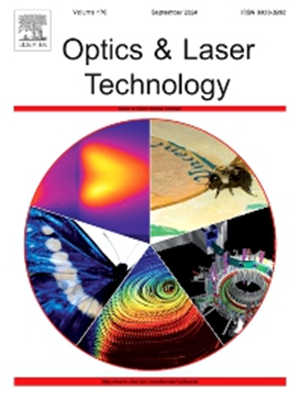通过隧道诱导透明和 Autler-Townes 分裂控制量子点分子系统中表面等离子体极化子的共振激发
IF 4.6
2区 物理与天体物理
Q1 OPTICS
引用次数: 0
摘要
电磁诱导透明(EIT)和 Autler-Townes 分裂(ATS)都会在吸收曲线中产生透明窗口,但 EIT 的不同之处在于它可以在弱控制场中产生透明窗口。为了阐明 EIT 和 ATS 效应所蕴含的不同物理机制,我们探索了在这两种情况下表面等离子体极化子 (SPP) 的受控共振激发。我们的装置由三层组成:顶层真空或空气层、中央金属膜和基于量子点分子(QDMs)系统的底层介质层。与采用棱镜或光栅耦合方案的典型系统不同,我们的装置利用量子点分子介质的独特特性来研究 SPPs 的直接共振激发。弱探针和强控制场通过空气或真空到达顶层。我们的结果表明,如果隧穿强度(Te)和直接激子的衰减率(Γ1)符合 Te/Γ1⩽0.5 的条件,底层介质的介电常数就会显示出隧穿诱导透明度(TIT);反之,则代表 ATS 效应。在这两种情况下,QDMs 介质的介电常数都满足低损耗(高传输)标准,即 Re [ɛd]<1 和 Im [ɛd]≪1,这为探索 SPPs 的控制谐振激励提供了一个框架。我们利用菲涅尔公式模拟了反射和透射光谱,发现反射光谱中出现了尖锐的凹点,透射光谱中出现了峰值,这是 SPPs 无耦合器共振激发的特征。我们注意到,TIT 中的窄峰值允许强光透射,因此 SPP 共振激发的峰值较高,从而提高了等离子传感器的灵敏度。相反,ATS 效应中两个峰值之间的大间距拓宽了 SPP 的有效激发频率范围,提高了系统在需要宽光谱响应的应用中的适应性和效率。本文章由计算机程序翻译,如有差异,请以英文原文为准。
Control resonant excitation of surface plasmon polariton in quantum-dot molecule system via tunneling induced transparency and Autler–Townes splitting
Electromagnetic induced transparency (EIT) and Autler–Townes splitting (ATS) both produce a transparency window in an absorption profile, yet EIT is distinct in that it can create a transparency window for a weak control field. To elucidate the distinct physical mechanisms underlying EIT and ATS effects, we explore the controlled resonant excitation of surface plasmon polaritons (SPPs) within these regimes. Our setup is composed of three layers: a top vacuum or air layer, a central metal film, and a bottom layer of dielectric medium based on the quantum-dot molecules (QDMs) system. Unlike typical systems, that employ prism or grating coupling scheme, our setup takes advantage of the unique features of the QDMs medium to investigate the direct resonance excitation of SPPs. A weak probe and a strong control field are carried through air or vacuum to the top layer. Our results demonstrate that the permittivity of the bottom medium displays tunneling induced transparency (TIT) if the tunneling strength () and the decay rate of the direct exciton () follow the condition ; otherwise, it represents the ATS effect. In both instances, the permittivity of the QDMs medium satisfy the low-loss (high transmission) criteria, i.e., Re and Im , providing a framework for exploring the control resonant excitation of SPPs. We simulate the reflection and transmission spectra using the Fresnel’s formula and noticed sharp dips in reflection and peaks in the transmission spectra, which are the signature of coupler free resonance excitation of SPPs. We noticed that the narrow peak in TIT allows for strong light transmission and thus a high peak in SPP resonance excitation, resulting in higher sensitivity in plasmonic sensors. Conversely, the large spacing between the two peaks in the ATS effect broadens the range of effective excitation frequencies for SPPs, increasing the system’s adaptability and efficiency in applications requiring broad spectrum responses.
求助全文
通过发布文献求助,成功后即可免费获取论文全文。
去求助
来源期刊
CiteScore
8.50
自引率
10.00%
发文量
1060
审稿时长
3.4 months
期刊介绍:
Optics & Laser Technology aims to provide a vehicle for the publication of a broad range of high quality research and review papers in those fields of scientific and engineering research appertaining to the development and application of the technology of optics and lasers. Papers describing original work in these areas are submitted to rigorous refereeing prior to acceptance for publication.
The scope of Optics & Laser Technology encompasses, but is not restricted to, the following areas:
•development in all types of lasers
•developments in optoelectronic devices and photonics
•developments in new photonics and optical concepts
•developments in conventional optics, optical instruments and components
•techniques of optical metrology, including interferometry and optical fibre sensors
•LIDAR and other non-contact optical measurement techniques, including optical methods in heat and fluid flow
•applications of lasers to materials processing, optical NDT display (including holography) and optical communication
•research and development in the field of laser safety including studies of hazards resulting from the applications of lasers (laser safety, hazards of laser fume)
•developments in optical computing and optical information processing
•developments in new optical materials
•developments in new optical characterization methods and techniques
•developments in quantum optics
•developments in light assisted micro and nanofabrication methods and techniques
•developments in nanophotonics and biophotonics
•developments in imaging processing and systems

 求助内容:
求助内容: 应助结果提醒方式:
应助结果提醒方式:


